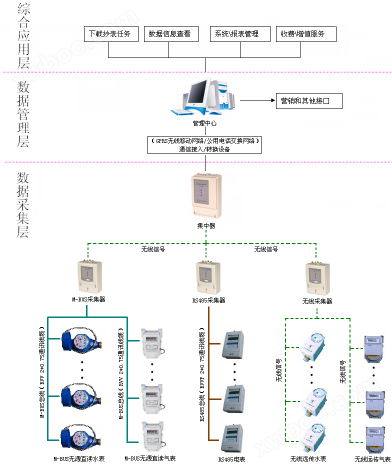The remote water and electricity meter reading system is a cost-effective remote automatic meter reading system launched by the company based on its advanced technology and the actual application needs of users. The system holdsBased on more than ten years of rich experience in similar products, the company has borrowed and combined advanced technological ideas from several well-known similar products at home and abroad, and applied advanced computer network technology, wireless network technology, automatic control technology, etc. It isCurrently, it is one of the most advanced remote meter reading systems in China. The system is based on the company's powerful technology platform and utilizes dozens of advanced and patented technologies to perfectly achieve remote monitoring of meter usage information and operation status. Administrators can monitor meter operation status and grasp energy consumption patterns without leaving their homes, providing a basis for the management department to allocate resources reasonably, save energy, and improve management efficiency.
system composition
The remote water and electricity meter reading system consists of intelligent meters, collectors, concentrators, and comprehensive meter reading control management system software. Among them, smart meters include M-BUS meters (water meters, gas meters, heat meters), RS485 energy meters, wireless remote transmission meters (water, electricity, gas, heat meters), and various smart meters with remote communication interfaces.
System Network Structure

As shown in the figure, the system has excellent compatibility and scalability, which can not only manage one type of smart meter, but also achieve comprehensive management of multiple types of smart meters such as water, electricity, gas, and heat meters. Common remote smart meters can be divided into three categories based on their network interfaces: wireless communication interfaces; The second is the RS485 bus interface; The third is the M-BUS bus interface. Smart meters with different network interfaces only need to be equipped with corresponding collectors, which can be shared by other devices (concentrators, management systems, etc.) to achieve unified management of multiple smart meters.
Communication method
System data communication consists of three levels: upper, middle, and lower. These three levels of communication are physically independent of each other and will be introduced below:
Upper level communication
Upper level communication refers to the communication between the concentrator and the management center computer. The characteristic of this layer of communication is that the data transmission volume is large and the transmission distance may be far.

As shown in the above figure, GPRS wireless mobile network and TCP/IP Ethernet are commonly used for upper layer communication. At the same time, the concentrator has RS232/485 communication and telephone line communication methods. However, GPRS 4G is still commonly used for convenience and speed.
Middle level communication
Mid level communication refers to the communication between the collector and the concentrator. The communication of this layer depends on the on-site construction environment and communication distance. Common methods include wireless low-power mode, power line carrier, and RS485 communication. The wireless low-power communication method can achieve a communication distance of over 300-3000m in open environments, and the wireless collector has wireless relay function. Currently, the most commonly used method is wireless low-power communication.
Lower level communication
Lower level communication refers to the communication between the collector and the smart meter, with three communication methods as shown in the following figure:


